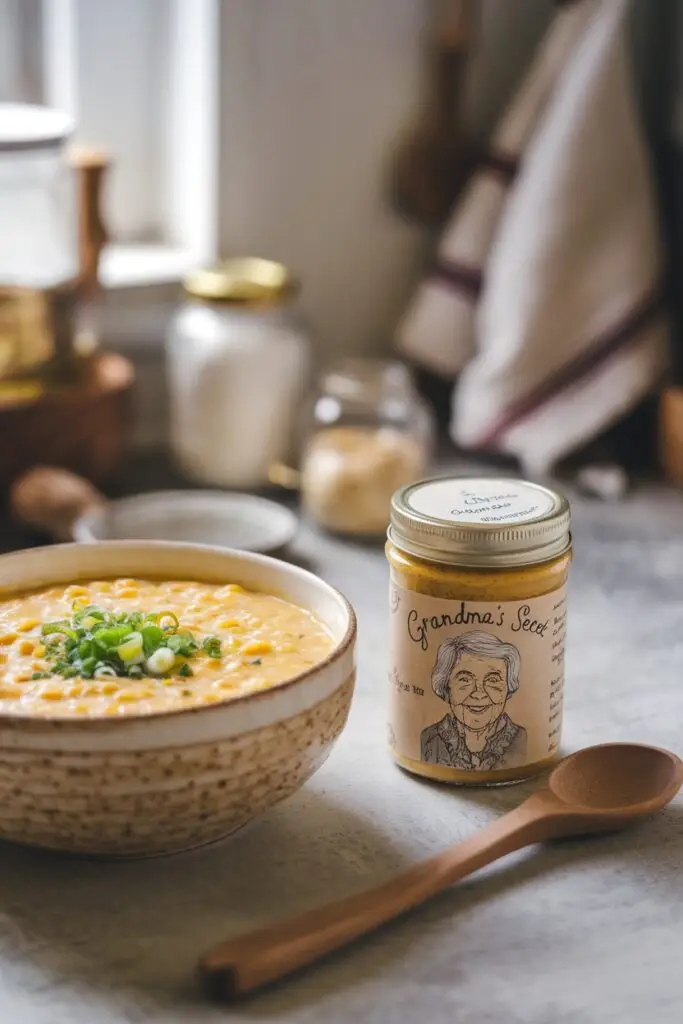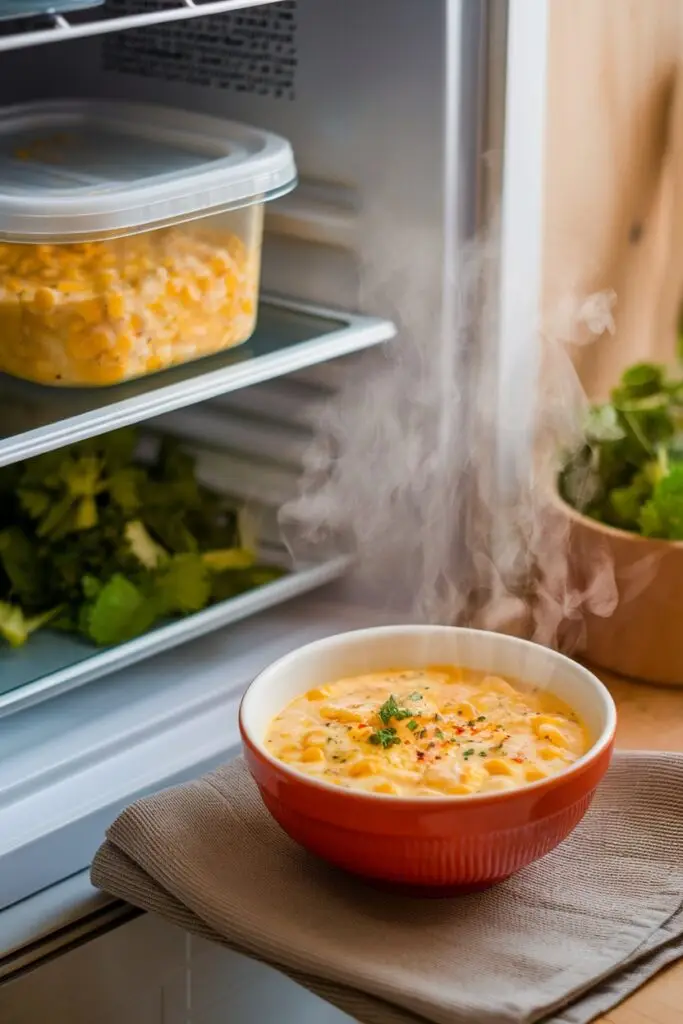
Corn chowder has always been a cherished dish in our family, but it was Grandma’s secret recipe that truly made it special. In this post, we’re diving into those time-tested ingredients and simple techniques that turn a classic chowder into a cozy bowl of comfort. Get ready to whip up a hearty meal that’ll remind you of home.
Table of Contents
Pairing Corn Chowder with Complementary Sides
Corn chowder is a comforting dish that brings warmth to any table. It’s creamy, filled with sweet corn, and packs a flavor punch that is both hearty and satisfying. This recipe is simple enough for a weeknight dinner yet special enough to serve at gatherings, making it a versatile favorite.
When it comes to pairing sides with corn chowder, fresh options work beautifully. A crisp garden salad adds a refreshing crunch, while warm, flaky biscuits are perfect for soaking up that delicious chowder. The combination creates a balanced meal that highlights the chowder’s rich flavors without overwhelming them.

Ingredients
- 4 cups fresh or frozen corn
- 1 onion, chopped
- 2 cloves garlic, minced
- 4 cups vegetable broth
- 2 cups heavy cream
- 1 tablespoon butter
- 1 teaspoon thyme
- Salt and pepper to taste
- Chopped parsley for garnish
Instructions
- In a large pot, melt the butter over medium heat. Add the onion and garlic, sautéing until softened.
- Add the corn and thyme, stirring for a few minutes. Pour in the vegetable broth and bring to a boil.
- Reduce the heat and let simmer for about 15 minutes, allowing the flavors to meld.
- Stir in the heavy cream and season with salt and pepper. Heat through but do not boil.
- Serve hot, garnished with chopped parsley.
Secret Ingredient for Grandma's Touch: The Corn Chowder Legacy
Corn chowder is a delightful blend of sweet corn, creamy goodness, and comforting spices that warms the heart. This recipe is not only simple to make but also filled with flavors that remind you of family gatherings around the dinner table. With each spoonful, you’ll experience a taste that feels like a warm hug, perfect for any chilly evening.
What sets this chowder apart is grandma’s secret ingredient: a hint of smoked paprika. This special touch enhances the natural sweetness of the corn, adding a subtle depth that elevates the dish. It’s an easy addition that transforms a classic into something memorable. Ready to bring a piece of grandma’s kitchen into your home? Let’s get cooking!

Ingredients
- 4 cups fresh corn (or canned, drained)
- 1 medium onion, diced
- 2 cloves garlic, minced
- 3 cups vegetable broth
- 1 cup heavy cream
- 2 medium potatoes, peeled and diced
- 1 teaspoon smoked paprika
- Salt and pepper to taste
- 2 tablespoons butter
- Chopped green onions for garnish
Instructions
- In a large pot, melt the butter over medium heat. Add the diced onion and garlic, cooking until softened and fragrant, about 5 minutes.
- Stir in the diced potatoes, corn, vegetable broth, and smoked paprika. Bring to a boil, then reduce heat and simmer for about 15 minutes, or until the potatoes are tender.
- Using an immersion blender, blend about half of the soup to create a creamy texture while keeping some whole corn and potato pieces for added texture. Alternatively, transfer half the soup to a blender, blend until smooth, and return to the pot.
- Stir in the heavy cream, and season with salt and pepper to taste. Heat through without boiling.
- Serve hot, garnished with chopped green onions.
Storing and Reheating Leftover Corn Chowder for Maximum Enjoyment
Corn chowder is a cozy dish that brings warmth and comfort with every spoonful. It’s creamy, slightly sweet, and filled with fresh corn and flavorful seasonings. Not only is it a delight to make, but it’s also easy to prepare, making it a favorite in many households.
When it comes to storing and reheating leftovers, corn chowder holds up well. To ensure your chowder stays delicious, refrigerate any leftovers in an airtight container. It can last for about three to four days in the fridge. When you’re ready to enjoy it again, simply reheat on the stove over low heat, stirring occasionally until it’s warmed through. You can add a splash of milk or cream if it’s thickened too much. Plus, a sprinkle of fresh herbs or a dash of seasoning can brighten it up!

Ingredients
- 4 cups fresh or frozen corn
- 1 medium onion, chopped
- 2 cloves garlic, minced
- 3 medium potatoes, diced
- 4 cups vegetable broth
- 1 cup heavy cream
- 2 tablespoons butter
- Salt and pepper to taste
- Fresh parsley for garnish
Instructions
- In a large pot, melt the butter over medium heat. Add the chopped onion and garlic, sauté until the onions are translucent.
- Add the diced potatoes and corn, stirring to combine. Pour in the vegetable broth and bring to a boil.
- Reduce the heat and let it simmer for about 15-20 minutes, or until the potatoes are tender.
- Stir in the heavy cream and season with salt and pepper. Heat through for another 5 minutes.
- Serve hot, garnished with fresh parsley.
Here's a tip for you
Corn Chowder's Hidden Heritage: Reclaiming Native Techniques and Forgotten Flavors
The Forgotten Indigenous Foundations
While corn chowder is celebrated as an American classic, its true origins reveal a deeper story rarely told in mainstream culinary narratives. Long before European colonization, indigenous peoples across North America created sophisticated corn-based soups using traditional techniques that modern chefs are only now beginning to rediscover. The Narragansett, Wampanoag, and other Northeastern tribes developed nourishing corn soups thickened not with flour or dairy—European additions that came later—but with ground nuts, particularly black walnuts and chestnuts, creating a naturally creamy texture with complex earthy undertones.
Three Sisters Agricultural System
What makes these indigenous preparations truly distinctive is their connection to the “Three Sisters” agricultural system—corn, beans, and squash grown together in a sustainable polyculture. This agricultural practice wasn’t just efficient; it produced corn with distinctive flavor profiles that modern mass-produced varieties can’t replicate. The resulting soups were both nutritionally complete and symbolically significant, representing the harmonious relationship between these companion plants.
The Transformative Power of Nixtamalization
Perhaps the most overlooked aspect of traditional corn chowder preparation—and what can make your recipe truly distinctive—is the ancient process of nixtamalization. This technique, developed by Mesoamerican cultures thousands of years ago, involves soaking and cooking dried corn kernels in an alkaline solution (traditionally using wood ash or limestone), which fundamentally transforms the grain in three crucial ways:
Nutritional and Culinary Benefits
- It significantly increases nutritional bioavailability, particularly niacin (vitamin B3), preventing pellagra—a disease that plagued many European-descendant communities who adopted corn without this crucial preparation step
- It enhances the natural flavor compounds in corn, releasing complex nutty and earthy notes
- It improves digestibility and creates a distinctive texture impossible to achieve with untreated corn
Modern chefs reviving this technique for corn chowder preparation report that nixtamalized corn creates a depth of flavor that transcends conventional recipes. While traditional nixtamalization is time-intensive, simplified modern methods using food-grade calcium hydroxide (cal) or even baking soda can make this technique accessible to home cooks seeking authentic flavors.
Regional Heirloom Varieties: The Secret Ingredient
The industrialization of corn production has led to a homogenization of flavor, with most recipes treating corn as a generic ingredient. However, historically informed corn chowder preparations recognize that specific regional varieties dramatically affect the final dish:
Heritage Corn Varieties and Their Unique Profiles
- ‘Narragansett White’ corn, an heirloom variety preserved by the tribe of the same name, produces a distinctively sweet, floral chowder that was once the standard in Rhode Island
- ‘Cherokee White Eagle’ corn imparts a rich, nutty profile that pairs beautifully with smoked ingredients
- ‘Hopi Blue’ corn creates a visually striking purplish chowder with deeper, earthier notes than yellow varieties
These heirloom varieties aren’t just culinary curiosities—they represent living cultural heritage. Organizations like Native Seeds/SEARCH and Seed Savers Exchange now make these varieties available to home gardeners and chefs committed to preserving biodiversity and authentic flavors.
Cultural Transformation Through Crisis
Corn chowder’s evolution through American history reveals fascinating adaptations during periods of scarcity. During the Great Depression, home economists promoted corn chowder as an economical yet complete meal. What’s rarely discussed is how these Depression-era adaptations permanently changed the dish:
Depression-Era Innovations
- Bacon drippings replaced more expensive salt pork
- Potatoes became more prominent as an economical extender
- Evaporated milk, a shelf-stable innovation, became common in recipes, creating a distinctive flavor note that many still associate with comfort food
These adaptations weren’t merely compromises—they created new flavor combinations that became cherished traditions in their own right, demonstrating how economic necessity drives culinary innovation.
The Modern Indigenous Food Sovereignty Movement
Today, a remarkable culinary revival is underway as Native American chefs reclaim and reimagine their food heritage. Restaurants like Owamni by Sean Sherman in Minneapolis and Tocabe in Denver are reintroducing pre-colonial preparation methods, creating corn chowder variations that challenge conventional assumptions about the dish:
Contemporary Indigenous Chefs and Their Approaches
- Chef Sherman’s version uses no dairy at all, instead achieving creaminess through traditional nut thickeners and coconut milk
- At the I-Collective, indigenous chefs create versions using heirloom Haudenosaunee corn varieties and traditional seasonings like white pine and sumac
- The Sioux Chef’s Indigenous Food Lab teaches traditional corn processing methods, helping communities reconnect with ancestral techniques
This movement isn’t merely about historical preservation—it represents a forward-looking approach to sustainability, nutrition, and cultural identity. For home cooks seeking to explore these authentic traditions, resources like “The Sioux Chef’s Indigenous Kitchen” by Sean Sherman provide accessible entry points to these ancient yet innovative techniques.
Connecting Past and Future
By incorporating these overlooked aspects of corn chowder’s heritage—from nixtamalization to heirloom varieties to indigenous thickening methods—you can create a dish that not only honors its complex cultural roots but also offers flavor dimensions that most diners have never experienced. This isn’t just cooking; it’s participating in the reclamation and continuation of living culinary traditions that connect us to the land and its first stewards.
If you want to discover more hidden culinary gems around the world, check out this page.

